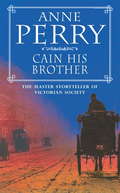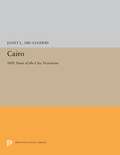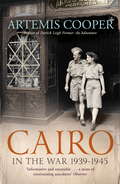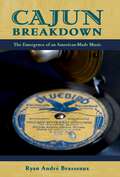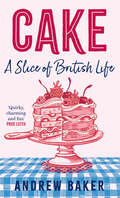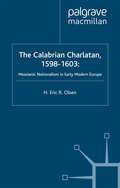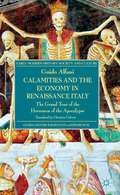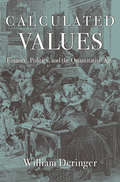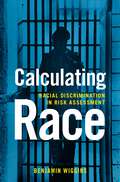- Table View
- List View
Cain His Brother: An atmospheric and compelling Victorian mystery (William Monk Mystery #6)
by Anne PerryWilliam Monk faces his most bizarre case to date... In the foggy streets of Victorian London, Investigator Monk continues to solve the city's crimes and murders, with Cain His Brother being the sixth instalment of Anne Perry's mystery series featuring the popular detective. Perfect for fans of C. J. Sansom and Sarah Perry.'Just when you think you have it figured out, think again! No one can capture and bring to life the drama, excitement, and feel of Victorian England like Perry' - Mostly Murder Genvieve Stonefield's husband Angus is missing when she seeks William Monk's help to find him. She is convinced that he has been murdered by his twin brother Caleb, a shadowy figure who lives in the slums bordering the Thames and has always hated his respectable businessman brother. Although worried about Hester Latterly's health as she nurses victims of a typhoid outbreak in Limehouse, and threatened by a personal scandal, Monk is determined to bring one of the most bizarre cases he has ever encountered to its conclusion. What readers are saying about Cain His Brother: 'This is the best one in the Monk series... this novel has a most baffling conclusion and left me reeling in surprise''Lots of twists to the tale, it'll have you hooked''Five stars'
Caine Black Knife: Book 3 of the Acts of Caine (Acts of Caine #3)
by Matthew StoverRedemption casts a bloody shadowOn Overworld, Caine was an assassin without peer - a legendary killer known as the Blade of Tyshalle. Back on Earth, Caine was Hari Michaelson, an actor whose bloodthirsty adventures in the Overworld made him superstar. In his last adventure, Caine almost single-handedly defeated and exterminated the fiercest of all tribes: the Black Knives. But the shocking truth of what happened during that vicious battle has never been revealed . . . until now.Years later, Caine returns to the scene of his greatest triumph - some would say greatest crime - at the request of his adopted brother, the last of the Black Knives. But where Caine goes, danger follows, and he soon finds himself fighting for his life against impossible odds, with the fate of two worlds hanging in the balance. Just the way Caine likes it.Welcome to the world of Caine: Assassin. Hero. Superstar . . .From a New York Times bestselling author comes the start of a gritty action fantasy series like no other - perfect for fans of Joe Abercrombie, Brent Weeks, Mark Lawrence and the Assassin's Creed novels. Praise for The Acts of Caine books:'A gritty, bloody, deeply touching work of genius' - Scott Lynch'Hands down one of the most bad-ass, brutal - and brilliant - fantasy series of the last double-decade. You know this if you're already reading it. If you're not already reading it, then good lord, it's time you found out - John Scalzi'If you like really really gritty, dark fantasy like George RR Martin, Richard Morgan (Takashi Kovaks books) or ESPECIALLY Joe Abercrombie, you should get this book' - Felicia Day
Caine's Law: Book 4 of the Acts of Caine (Acts of Caine #4)
by Matthew StoverSome laws you break. And some break you. And then there's Caine's Law.The assassin Caine: a civilized man who embraced savagery, an actor whose life was a lie, a force of destruction so potent that even gods thought twice about crossing him. Now the legendary killer is back for his most stunning and bloodthirsty performance yet.Caine is washed up and hung out to dry, a crippled husk kept isolated and restrained by the studio that exploited him. Now they have dragged him back for one last deal. But Caine has other plans. Those plans take him back to Overworld, the alternate reality where gods are real and magic is the ultimate weapon. There, in a violent odyssey, Caine will face the demons of his past, find true love, and just possibly destroy the universe.Welcome to the world of Caine: Assassin. Hero. Superstar . . .From a New York Times bestselling author comes the start of a gritty action fantasy series like no other - perfect for fans of Joe Abercrombie, Brent Weeks, Mark Lawrence and the Assassin's Creed novels. Praise for The Acts of Caine books:'A gritty, bloody, deeply touching work of genius' - Scott Lynch'Hands down one of the most bad-ass, brutal - and brilliant - fantasy series of the last double-decade. You know this if you're already reading it. If you're not already reading it, then good lord, it's time you found out - John Scalzi'If you like really really gritty, dark fantasy like George RR Martin, Richard Morgan (Takashi Kovaks books) or ESPECIALLY Joe Abercrombie, you should get this book' - Felicia Day
The Cairngorms: A Secret History
by Patrick BakerThe Cairngorms: A Secret History is a series of journeys exploring barely known human and natural stories of the Cairngorm Mountains. It looks at a unique British landscape, its last great wilderness, with new eyes. History combines with travelogue in a vivid account of this elemental scenery. There have been rare human incursions into the Cairngorm plateau, and Patrick Baker tracks them down. He traces elusive wildlife and relives ghostly sightings on the summit of Ben Macdui. From the search for a long-forgotten climbing shelter and the locating of ancient gem mines, to the discovery of skeletal aircraft remains and the hunt for a mysterious nineteenth-century aristocratic settlement, he seeks out the unlikeliest and most interesting of features in places far off the beaten track. The cultural and human impact of this stunning landscape and reflections on the history of mountaineering are the threads which bind this compelling narrative together.
Cairo: 1001 Years of the City Victorious (The William G. Bowen Series #1)
by Janet L. Abu-Lughod1001 years as a continuous settlement, 100 years as a modern city, Cairo in the 1970s is a complex metropolis. Janet Abu-Lughod traces the social and demographic history of Cairo, demonstrating the continuities and transformations that underlie the organization of today's city.Originally published in 1971.The Princeton Legacy Library uses the latest print-on-demand technology to again make available previously out-of-print books from the distinguished backlist of Princeton University Press. These editions preserve the original texts of these important books while presenting them in durable paperback and hardcover editions. The goal of the Princeton Legacy Library is to vastly increase access to the rich scholarly heritage found in the thousands of books published by Princeton University Press since its founding in 1905.
Cairo 1921: Ten Days that Made the Middle East
by C. Brad FaughtThe first comprehensive history of the 1921 Cairo Conference which reveals its enduring impact on the modern Middle East Called by Winston Churchill in 1921, the Cairo Conference set out to redraw the map of the Middle East in the wake of the First World War and the collapse of the Ottoman Empire. The summit established the states of Iraq and Jordan as part of the Sherifian Solution and confirmed the establishment of a Jewish homeland in Palestine—the future state of Israel. No other conference had such an enduring impact on the region. C. Brad Faught demonstrates how the conference, although dominated by the British with limited local participation, was an ambitious, if ultimately unsuccessful, attempt to move the Middle East into the world of modern nationalism. Faught reveals that many officials, including T. E. Lawrence and Gertrude Bell, were driven by the determination for state building in the area to succeed. Their prejudices, combined with their abilities, would profoundly alter the Middle East for decades to come.
The Cairo Genizah and the Age of Discovery in Egypt: The History and Provenance of a Jewish Archive
by Rebecca J. JeffersonThe Cairo Genizah is considered one of the world's greatest Hebrew manuscript treasures. Yet the story of how over a quarter of a million fragments hidden in Egypt were discovered and distributed around the world, before becoming collectively known as “The Cairo Genizah,” is far more convoluted and compelling than previously told. The full story involves an international cast of scholars, librarians, archaeologists, excavators, collectors, dealers and agents, operating from the mid-nineteenth to the early twentieth century, and all acting with varying motivations and intentions in a race for the spoils.Basing her research on a wealth of archival materials, Jefferson reconstructs how these protagonists used their various networks to create key alliances, or to blaze lone trails, each one on a quest to recover ancient manuscripts. Following in their footsteps, she takes the reader on a journey down into ancient caves and tombs, under medieval rubbish mounds, into hidden attic rooms, vaults, basements and wells, along labyrinthine souks, and behind the doors of private clubs and cloistered colleges. Along the way, the reader will also learn about the importance of establishing manuscript provenance and authenticity, and the impact to our understanding of the past when either factor is in doubt.
The Cairo Genizah and the Age of Discovery in Egypt: The History and Provenance of a Jewish Archive
by Rebecca J. JeffersonThe Cairo Genizah is considered one of the world's greatest Hebrew manuscript treasures. Yet the story of how over a quarter of a million fragments hidden in Egypt were discovered and distributed around the world, before becoming collectively known as “The Cairo Genizah,” is far more convoluted and compelling than previously told. The full story involves an international cast of scholars, librarians, archaeologists, excavators, collectors, dealers and agents, operating from the mid-nineteenth to the early twentieth century, and all acting with varying motivations and intentions in a race for the spoils.Basing her research on a wealth of archival materials, Jefferson reconstructs how these protagonists used their various networks to create key alliances, or to blaze lone trails, each one on a quest to recover ancient manuscripts. Following in their footsteps, she takes the reader on a journey down into ancient caves and tombs, under medieval rubbish mounds, into hidden attic rooms, vaults, basements and wells, along labyrinthine souks, and behind the doors of private clubs and cloistered colleges. Along the way, the reader will also learn about the importance of establishing manuscript provenance and authenticity, and the impact to our understanding of the past when either factor is in doubt.
Cairo in the War: 1939-45
by Artemis CooperFor troops in the desert, Cairo meant fleshpots or brass hats. For well-connected officers, it meant polo at the Gezira Club and drinks at Shepheard's. For the irregular warriors, Cairo was a city to throw legendary parties before the next mission behind enemy lines. For countless refugees, it was a stopping place in the long struggle home. The political scene was dominated by the British Ambassador Sir Miles Lampson. In February 1942 he surrounded the Abdin Palace with tanks and attempted to depose King Farouk. Five months later it looked as if the British would be thrown out of Egypt for good. Rommel's forces were only sixty miles from Alexandria - but the Germans were pushed back and Cairo life went on. Meanwhile, in the Egyptian Army, a handful of young officers were thinking dangerous thoughts.
Cajun Breakdown: The Emergence of an American-Made Music (American Musicspheres)
by Ryan Andre BrasseauxIn 1946, Harry Choates, a Cajun fiddle virtuoso, changed the course of American musical history when his recording of the so-called Cajun national anthem "Jole Blon" reached number four on the national Billboard charts. Cajun music became part of the American consciousness for the first time thanks to the unprecedented success of this issue, as the French tune crossed cultural, ethnic, racial, and socio-economic boundaries. Country music stars Moon Mullican, Roy Acuff, Bob Wills, and Hank Snow rushed into the studio to record their own interpretations of the waltz-followed years later by Waylon Jennings and Bruce Springsteen. The cross-cultural musical legacy of this plaintive waltz also paved the way for Hank Williams Sr.'s Cajun-influenced hit "Jamabalaya." Choates' "Jole Blon" represents the culmination of a centuries-old dialogue between the Cajun community and the rest of America. Joining into this dialogue is the most thoroughly researched and broadly conceived history of Cajun music yet published, Cajun Breakdown. Furthermore, the book examines the social and cultural roots of Cajun music's development through 1950 by raising broad questions about the ethnic experience in America and nature of indigenous American music. Since its inception, the Cajun community constantly refashioned influences from the American musical landscape despite the pressures of marginalization, denigration, and poverty. European and North American French songs, minstrel tunes, blues, jazz, hillbilly, Tin Pan Alley melodies, and western swing all became part of the Cajun musical equation. The idiom's synthetic nature suggests an extensive and intensive dialogue with popular culture, extinguishing the myth that Cajuns were an isolated folk group astray in the American South. Ryan André Brasseaux's work constitutes a bold and innovative exploration of a forgotten chapter in America's musical odyssey.
Cake: A Slice Of British Life
by Andrew Baker‘A delightful odyssey through the history, nostalgia, fascination and British love of cake. Quirky, charming, and fun.’ PRUE LEITH
Cake: A Slice Of History
by Alysa LeveneIf you have wondered about the stories behind the cakes made on the Great British Bake Off or the difference between a Victoria sandwich and a sponge cake (especially if Mary Berry or Nigella Lawson is not to hand), this is the book for you. Baking has always been about memories passed down through families and Alysa Levene will take you through this compelling social history of baking.'My sister had three wedding cakes. Rather than spend a lot of money on a traditional cake she asked our grandmother, our mother, and our step-mother to make their signature bakes. My grandmother made the rich fruit cake she always baked at Christmas. My mother made a chocolate sponge which we called Queenie's Chocolate Cake after the great aunt who gave her the recipe; it appeared at almost every one of our birthdays in one guise or another. And finally, my step-mother made chocolate brownies (Nigella Lawson's recipe, if you'd like to know), whose sticky, pleasurable unctuousness is fully explained by the amount of butter they contain. 'In our family, as in many others, these familiar cakes are the makers of memories. My siblings and I took this idea into our adult lives, and now bake for our own families. But it wasn't until I developed an interest in the history of food that I started to think about the deeper significance of these tasty treats. What does cake mean for different people? How have we come to have such a huge variety of cakes? What had to happen historically for them to appear? And what can they tell us about the family, and women's roles in particular? I wrote this book to find out the answers.'What follows is a journey from King Alfred to our modern-day love of cupcakes, via Queen Victoria's patriotic sandwich, the Southern States of America, slavery and the spice trade, to the rise of the celebrity chef . . . and so much more.
The Calabrian Charlatan, 1598–1603: Messianic Nationalism in Early Modern Europe (Early Modern History: Society and Culture)
by E. OlsenIn 1598 a man - branded the Calabrian Charlatan by his Spanish opponents - appeared in Venice claiming to be King Sebastian, the Portuguese monarch who disappeared in battle some twenty years before. Over the next five years Venetians, Spaniards, and Portuguese wrangled over the true character and identity of the man. Was he a lunatic? Was he an impostor? Was he a messianic king? Eric Olsen uses this strange event to explore Portuguese millenarianism and how a group of Portuguese rebels sought to exploit it to free their nation from Spain.
Calamities and the Economy in Renaissance Italy: The Grand Tour of the Horsemen of the Apocalypse (Early Modern History: Society and Culture)
by G. AlfaniItaly faced a number of catastrophes in the long sixteenth century. This economic and demographic history follows the consequences of these catastrophes - the action of the Horsemen of the Apocalypse - War, Famine and Plague, all followed by Death.
Calamity: The Many Lives of Calamity Jane
by Karen R. JonesA fascinating new account of the life and legend of the Wild West’s most notorious woman: Calamity Jane Martha Jane Canary, popularly known as Calamity Jane, was the pistol-packing, rootin’ tootin’ "lady wildcat" of the American West. Brave and resourceful, she held her own with the men of America’s most colorful era and became a celebrity both in her own right and through her association with the likes of Wild Bill Hickok and Buffalo Bill Cody. In this engaging account, Karen Jones takes a fresh look at the story of this iconic frontierswoman. She pieces together what is known of Canary’s life and shows how a rough and itinerant lifestyle paved the way for the scattergun, alcohol-fueled heroics that dominated Canary’s career. Spanning Canary’s rise from humble origins to her role as "heroine of the plains" and the embellishment of her image over subsequent decades, Jones shows her to be feisty, eccentric, transgressive—and very much complicit in the making of the myth that was Calamity Jane.
Calculated Values: Finance, Politics, and the Quantitative Age
by William DeringerModern political culture features a deep-seated faith in the power of numbers to find answers, settle disputes, and explain how the world works. Whether evaluating economic trends, measuring the success of institutions, or divining public opinion, we are told that numbers don’t lie. But numbers have not always been so revered. Calculated Values traces how numbers first gained widespread public authority in one nation, Great Britain. Into the seventeenth century, numerical reasoning bore no special weight in political life. Complex calculations were often regarded with suspicion, seen as the narrow province of navigators, bookkeepers, and astrologers, not gentlemen. This changed in the decades following the Glorious Revolution of 1688. Though Britons’ new quantitative enthusiasm coincided with major advances in natural science, financial capitalism, and the power of the British state, it was no automatic consequence of those developments, William Deringer argues. Rather, it was a product of politics—ugly, antagonistic, partisan politics. From Parliamentary debates to cheap pamphlets, disputes over taxes, trade, and national debt were increasingly conducted through calculations. Some of the era’s most pivotal political moments, like the 1707 Union of England and Scotland and the 1720 South Sea Bubble, turned upon calculative conflicts. As Britons learned to fight by the numbers, they came to believe, as one calculator wrote in 1727, that “facts and figures are the most stubborn evidences.” Yet the authority of numbers arose not from efforts to find objective truths that transcended politics, but from the turmoil of politics itself.
Calculated Values: Finance, Politics, and the Quantitative Age
by William DeringerModern political culture features a deep-seated faith in the power of numbers to find answers, settle disputes, and explain how the world works. Whether evaluating economic trends, measuring the success of institutions, or divining public opinion, we are told that numbers don’t lie. But numbers have not always been so revered. Calculated Values traces how numbers first gained widespread public authority in one nation, Great Britain. Into the seventeenth century, numerical reasoning bore no special weight in political life. Complex calculations were often regarded with suspicion, seen as the narrow province of navigators, bookkeepers, and astrologers, not gentlemen. This changed in the decades following the Glorious Revolution of 1688. Though Britons’ new quantitative enthusiasm coincided with major advances in natural science, financial capitalism, and the power of the British state, it was no automatic consequence of those developments, William Deringer argues. Rather, it was a product of politics—ugly, antagonistic, partisan politics. From Parliamentary debates to cheap pamphlets, disputes over taxes, trade, and national debt were increasingly conducted through calculations. Some of the era’s most pivotal political moments, like the 1707 Union of England and Scotland and the 1720 South Sea Bubble, turned upon calculative conflicts. As Britons learned to fight by the numbers, they came to believe, as one calculator wrote in 1727, that “facts and figures are the most stubborn evidences.” Yet the authority of numbers arose not from efforts to find objective truths that transcended politics, but from the turmoil of politics itself.
Calculating compassion: Humanity and relief in war, Britain 1870–1914 (Humanitarianism: Key Debates and New Approaches)
by Rebecca GillCalculating compassion examines the origins of British relief work in late-nineteenth-century wars on the continent and the fringes of Empire. Commencing with the Franco-Prussian war of 1870–71, it follows distinguished surgeons and ‘lady amateurs’ as they distributed aid to wounded soldiers and distressed civilians, often in the face of considerable suspicion. Dispensing with the notion of shared ‘humanitarian’ ideals, it examines the complex, and sometimes controversial, origins of organised relief, and illuminates the emergence of practices and protocols still recognisable in the delivery of overseas aid. This book is intended for students, academics and relief practitioners interested in the historical concerns of first generation relief agencies such as the British Red Cross Society and the Save the Children Fund, and their legacies today.
Calculating compassion: Humanity and relief in war, Britain 1870–1914 (Humanitarianism: Key Debates and New Approaches)
by Rebecca GillCalculating compassion examines the origins of British relief work in late-nineteenth-century wars on the continent and the fringes of Empire. Commencing with the Franco-Prussian war of 1870–71, it follows distinguished surgeons and ‘lady amateurs’ as they distributed aid to wounded soldiers and distressed civilians, often in the face of considerable suspicion. Dispensing with the notion of shared ‘humanitarian’ ideals, it examines the complex, and sometimes controversial, origins of organised relief, and illuminates the emergence of practices and protocols still recognisable in the delivery of overseas aid. This book is intended for students, academics and relief practitioners interested in the historical concerns of first generation relief agencies such as the British Red Cross Society and the Save the Children Fund, and their legacies today.
A Calculating People: The Spread of Numeracy in Early America
by Patricia Cline CohenNow back in print, A Calculating People reveals how numeracy profoundly shaped the character of society in the early republic and provides a wholly original perspective on the development of modern America.
A Calculating People: The Spread of Numeracy in Early America
by Patricia Cline CohenNow back in print, A Calculating People reveals how numeracy profoundly shaped the character of society in the early republic and provides a wholly original perspective on the development of modern America.
Calculating Race: Racial Discrimination in Risk Assessment
by Benjamin WigginsIn Calculating Race, Benjamin Wiggins analyzes the historical relationship between statistical risk assessment and race in the United States. He illustrates how, through a reliance on the variable of race, actuarial science transformed the nature of racism and helped usher racial disparities in wealth, incarceration, and housing from the nineteenth century into the twentieth. Wiggins begins by tracing how the life insurance industry utilized race in its calculations at the end of the nineteenth century, focusing particularly on Prudential and its aggressive battles with state regulators to discriminate against clients and adjust rates on the basis of race. He then turns his focus to the collection of racial statistics in the Illinois state penitentiary system in the late nineteenth century and the state's subsequent development of predictive sentencing and parole formulas in the 1920s that weighed race as a key factor. Next, he investigates the role of race in the state-sponsored mortgage insurance program of the Federal Housing Administration between the start of the New Deal and the beginning of the Cold War and its prolonged effects on mortgage lending. Wiggins concludes with an analysis of the use of race in the statistical risk assessments across financial institutions and government programs during the post-civil rights movement era, and how that practice has been transformed in the twenty-first century through "proxy" variables which stand in for the now taboo category of race. Offering readers a new perspective on the historical importance of actuarial science in structural racism, Calculating Race is a particularly timely contribution as Big Data and algorithmic decision making increasingly pervade our lives.
Calculating Race: Racial Discrimination in Risk Assessment
by Benjamin WigginsIn Calculating Race, Benjamin Wiggins analyzes the historical relationship between statistical risk assessment and race in the United States. He illustrates how, through a reliance on the variable of race, actuarial science transformed the nature of racism and helped usher racial disparities in wealth, incarceration, and housing from the nineteenth century into the twentieth. Wiggins begins by tracing how the life insurance industry utilized race in its calculations at the end of the nineteenth century, focusing particularly on Prudential and its aggressive battles with state regulators to discriminate against clients and adjust rates on the basis of race. He then turns his focus to the collection of racial statistics in the Illinois state penitentiary system in the late nineteenth century and the state's subsequent development of predictive sentencing and parole formulas in the 1920s that weighed race as a key factor. Next, he investigates the role of race in the state-sponsored mortgage insurance program of the Federal Housing Administration between the start of the New Deal and the beginning of the Cold War and its prolonged effects on mortgage lending. Wiggins concludes with an analysis of the use of race in the statistical risk assessments across financial institutions and government programs during the post-civil rights movement era, and how that practice has been transformed in the twenty-first century through "proxy" variables which stand in for the now taboo category of race. Offering readers a new perspective on the historical importance of actuarial science in structural racism, Calculating Race is a particularly timely contribution as Big Data and algorithmic decision making increasingly pervade our lives.
Calculation and Computation in the Pre-electronic Era: The Mechanical and Electrical Ages (History of Computing)
by Aristotle TympasAlthough it is popularly assumed that the history of computing before the second half of the 20th century was unimportant, in fact the Industrial Revolution was made possible and even sustained by a parallel revolution in computing technology. An examination and historiographical assessment of key developments helps to show how the era of modern electronic computing proceeded from a continual computing revolution that had arisen during the mechanical and the electrical ages.This unique volume introduces the history of computing during the “first” (steam) and “second” (electricity) segments of the Industrial Revolution, revealing how this history was pivotal to the emergence of electronic computing and what many historians see as signifying a shift to a post-industrial society. It delves into critical developments before the electronic era, focusing on those of the mechanical era (from the emergence of the steam engine to that of the electric power network) and the electrical era (from the emergence of the electric power network to that of electronic computing). In so doing, it provides due attention to the demarcations between—and associated classifications of—artifacts for calculation during these respective eras. In turn, it emphasizes the history of comparisons between these artifacts.Topics and Features:motivates exposition through a firm historiographical argument of important developmentsexplores the history of the slide rule and its use in the context of electrificationexamines the roles of analyzers, graphs, and a whole range of computing artifacts hitherto placed under the allegedly inferior class of analog computersshows how the analog and the digital are really inseparable, with perceptions thereof depending on either a full or a restricted view of the computing processinvestigates socially situated comparisons of computing history, including the effects of a political economy of computing (one that takes into account cost and ownership of computing artifacts)assesses concealment of analog-machine labor through encasement (“black-boxing”)Historians of computing, as well as those of technology and science (especially, energy), will find this well-argued and presented history of calculation and computation in the mechanical and electrical eras an indispensable resource. The work is a natural textbook companion for history of computing courses, and will also appeal to the broader readership of curious computer scientists and engineers, as well as those who generally just have a yearn to learn the contextual background to the current digital age."In this fascinating, original work, Tympas indispensably intertwines the histories of analog and digital computing, showing them to be inseparable from the evolution of social and economic conditions. " Prof. David Mindell, MIT
Calculation and Morality: The Costs of Slavery and the Value of Emancipation in the French Antilles (Oxford Studies in History of Economics)
by Caroline Oudin-Bastide Philippe SteinerDebates about whether to maintain or abolish slavery revolved around two key values: the morality of enslaving other human beings and the economic benefits and costs of slavery as compared to free labor. Various and conflicting arguments were presented by abolitionists, colonists, and administrators in slave-holding societies, all of whom used calculations about the relative cost and productivity of slavery to defend their own point of view in an impassioned debate. In Calculation and Morality, Caroline Oudin-Bastide and Philippe Steiner consider how economic calculations, estimations, and arguments informed the long debate over French slavery between 1771 and 1848. They show how calculation was introduced into moral debate and became a critical social object in regard both to its consistency and its manifest effects. To do so they trace a process in which phenomena were classified into groups, becoming a category, and then how metrics and calculations were used to analyze the possible effects of emancipating slaves in French colonies. Abolitionists sought to demonstrate that it was in the interest of slaveowners and/or the entire nation to employ free labour in the colonies, and to show the irrationality of the colonial and metropolitan defenders of servitude; their aim was to enlighten various parties as to their real interest, and how that real interest coincided with justice. In turn, colonists accused those opposed to slavery of being blinded by their own philanthropic principles and insisted on the rationality of the slave system as the only means of meeting the interests of everyone, including slaves, at least in the short and medium term. Oudin-Bastide and Steiner closely examine the positions and reasoning of such influential French thinkers as Pierre Samuel Du Pont de Nemours, Anne Robert Jacques Turgot, Antoine Nicolas de Condorcet, Simonde de Sismondi, Jean Baptiste Say, and Alexis de Tocqueville. In doing so they shed light on the interaction of moral precepts and econonomic calculations in a trenchant study in the history of ideas.
